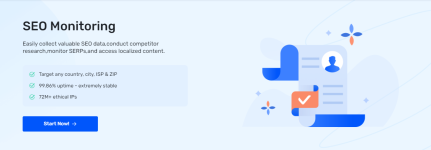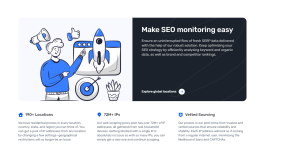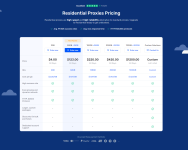weitang
New member
In the advanced version of the SEO monitoring tutorial, incorporating the use of proxies can significantly improve the efficiency and accuracy of data collection for better optimization and tuning of SEO strategies. These will be explained below in 6 points, read to the end of the article and be surprised~

1. Collect and expand your industry's statistics
First, find the statistics of your industry, use tools such as Google Analytics or Semrush, etc., combined with the information obtained, continue to write and expand this statistics, monitor and analyze keywords and competitors' dynamics. Second, using proxies, you can simulate user behavior in different geographic locations to get more comprehensive data. Focusing on data points that are often overlooked or missed, such as changes in search volume for long-tail keywords, we can see data that lasts for days, as well as overlooked and missed droplets in the ocean that will help you better understand market dynamics, select content, and find information relevant to your industry.
Here's the gateway to accessing residential proxies.
In the meantime, I'll include the code you may need to grab the data as shown below:
Sample code to grab data using residential proxies
Assuming that you already have a Python environment and relevant libraries (such as requests), here is a simple code example for crawling web data using residential proxies:
When using residential proxies, make sure that your proxy provider supports high anonymity and the required geolocation of the target site. The above example is just a basic primer. In practice, you may need to handle more exceptions, configure complex request headers, and so on.
2. Control website loading speed
Nowadays, Google does not require your website to be published frequently, and does not prioritize fast-loading websites, but does penalize slow-loading websites.Google will demote slow-loading networks, and if your website loads at a threshold, it will be ranked the same as some websites. Go to Google's Page Speed insights and enter your webpage's highest trafficked feature page or blog post, so you can see your own problems in the "Crawl Errors" error area and make targeted changes, by the way, if it is a 404 or an individual two errors is not relevant, but if there are more errors, it will not matter, but if there are more errors, it will not matter. By the way, if it is 404 or a few two errors is not relevant, but if there are more errors, you need to start correcting in time.
3. Select keywords

Choose keywords that are closely related to your business, these keywords should have a certain amount of search volume but not fierce competition. Use keyword planning tools (such as Google Keyword Planner) to identify these keywords. It is best to have more of your keywords in the opening section; Google wants the beginning of the article to be a summary of the comprehensive content. At the same time, the use of proxies can help you get keyword search trends in different regions to adapt to the needs of different markets for the purpose of seo monitoring.
4. Pay attention to typography and content design
Pay attention to typography, otherwise the content is no one will watch. Content should not only be attractive, but also easy to read, using easy-to-read fonts, simple layout, and reasonable use of a large number of headings and subheadings to separate the text. This not only improves user experience, but also helps search engines better understand and index your content.
5. Establish backlinks
Build backlinks by writing high-quality content and exchanging links with other websites. Backlinks are an important part of SEO and help boost your website's authority and search engine rankings. Step 1: Find the page you want to get a link from; Step 2: Find the broken link on that page; Step 3: Let the website owner know that their page is broken. Search for keywords + the resources you need above the Google search bar, which will open up sites with tons of external links. You can install a plugin for Chrome to check for broken links, run Check My Links to do so, and then you can contact the website owner to offer to provide their link.
Then you can write an email with my text:
Hi <NAME>, I was looking for some information on <NAME>.
I was looking for some information on <TOPIC> today when I came across your list of <TOPIC> resources.
Great stuff!
I couldn't help but notice that there was a broken link on the page.
<BROKEN URL>
I just thought you'd like to know.
Also, I recently published a guide on <TOPIC>. It might makea nice addition to your page.

6. Summarize:
By using proxies for SEO monitoring, you can more accurately model and analyze user behavior and search trends in different geographic locations, which helps to identify new keyword opportunities and monitor competitors. At the same time, optimizing your website's loading speed and content layout can enhance user experience and satisfy search engines, while building effective backlinks is a key step in improving your website's authority and search rankings. With a combination of these strategies, you can significantly improve your SEO results and better achieve your marketing goals.
Thank you for reading this far, here is a free proxies page for you to try!

1. Collect and expand your industry's statistics
First, find the statistics of your industry, use tools such as Google Analytics or Semrush, etc., combined with the information obtained, continue to write and expand this statistics, monitor and analyze keywords and competitors' dynamics. Second, using proxies, you can simulate user behavior in different geographic locations to get more comprehensive data. Focusing on data points that are often overlooked or missed, such as changes in search volume for long-tail keywords, we can see data that lasts for days, as well as overlooked and missed droplets in the ocean that will help you better understand market dynamics, select content, and find information relevant to your industry.
Here's the gateway to accessing residential proxies.
In the meantime, I'll include the code you may need to grab the data as shown below:
Sample code to grab data using residential proxies
Assuming that you already have a Python environment and relevant libraries (such as requests), here is a simple code example for crawling web data using residential proxies:
Code:
Python
import requests
# proxy server information, replace with your proxies address and port
proxy = 'http://<your-proxy-ip>:<proxy-port>'
proxies = {
'http': proxy,
'https': proxy
}
# Target url, replace with the site you want to crawl
url = 'http://example.com'
try.
response = requests.get(url, proxies=proxies)
response.raise_for_status()
# Parse the page or do a data crawl
print(response.text)
except requests.exceptions.HTTPError as err: # Parsing the page or crawling the data.
HTTPError as err: print(err)When using residential proxies, make sure that your proxy provider supports high anonymity and the required geolocation of the target site. The above example is just a basic primer. In practice, you may need to handle more exceptions, configure complex request headers, and so on.
2. Control website loading speed
Nowadays, Google does not require your website to be published frequently, and does not prioritize fast-loading websites, but does penalize slow-loading websites.Google will demote slow-loading networks, and if your website loads at a threshold, it will be ranked the same as some websites. Go to Google's Page Speed insights and enter your webpage's highest trafficked feature page or blog post, so you can see your own problems in the "Crawl Errors" error area and make targeted changes, by the way, if it is a 404 or an individual two errors is not relevant, but if there are more errors, it will not matter, but if there are more errors, it will not matter. By the way, if it is 404 or a few two errors is not relevant, but if there are more errors, you need to start correcting in time.
3. Select keywords

Choose keywords that are closely related to your business, these keywords should have a certain amount of search volume but not fierce competition. Use keyword planning tools (such as Google Keyword Planner) to identify these keywords. It is best to have more of your keywords in the opening section; Google wants the beginning of the article to be a summary of the comprehensive content. At the same time, the use of proxies can help you get keyword search trends in different regions to adapt to the needs of different markets for the purpose of seo monitoring.
4. Pay attention to typography and content design
Pay attention to typography, otherwise the content is no one will watch. Content should not only be attractive, but also easy to read, using easy-to-read fonts, simple layout, and reasonable use of a large number of headings and subheadings to separate the text. This not only improves user experience, but also helps search engines better understand and index your content.
5. Establish backlinks
Build backlinks by writing high-quality content and exchanging links with other websites. Backlinks are an important part of SEO and help boost your website's authority and search engine rankings. Step 1: Find the page you want to get a link from; Step 2: Find the broken link on that page; Step 3: Let the website owner know that their page is broken. Search for keywords + the resources you need above the Google search bar, which will open up sites with tons of external links. You can install a plugin for Chrome to check for broken links, run Check My Links to do so, and then you can contact the website owner to offer to provide their link.
Then you can write an email with my text:
Hi <NAME>, I was looking for some information on <NAME>.
I was looking for some information on <TOPIC> today when I came across your list of <TOPIC> resources.
Great stuff!
I couldn't help but notice that there was a broken link on the page.
<BROKEN URL>
I just thought you'd like to know.
Also, I recently published a guide on <TOPIC>. It might makea nice addition to your page.

6. Summarize:
By using proxies for SEO monitoring, you can more accurately model and analyze user behavior and search trends in different geographic locations, which helps to identify new keyword opportunities and monitor competitors. At the same time, optimizing your website's loading speed and content layout can enhance user experience and satisfy search engines, while building effective backlinks is a key step in improving your website's authority and search rankings. With a combination of these strategies, you can significantly improve your SEO results and better achieve your marketing goals.
Thank you for reading this far, here is a free proxies page for you to try!

